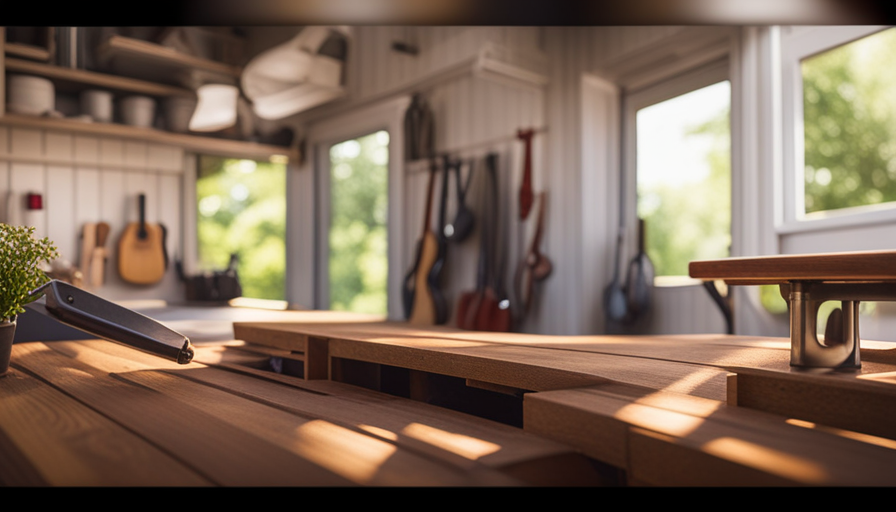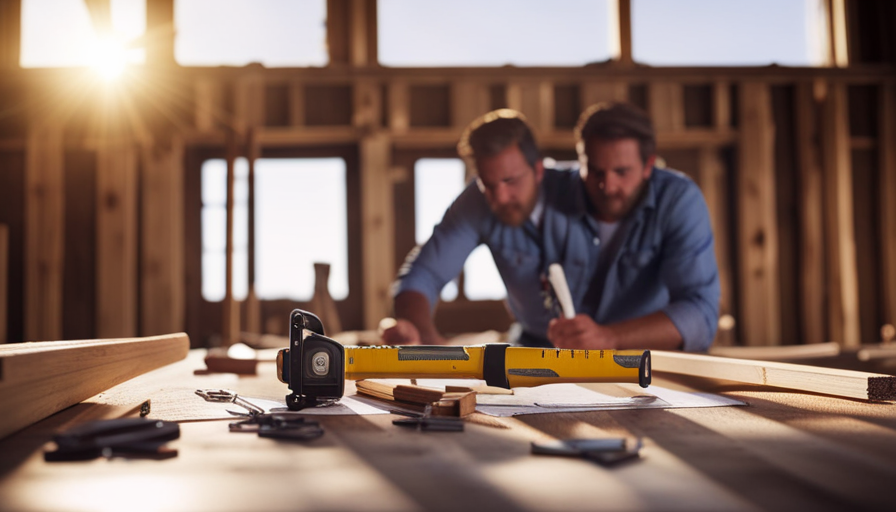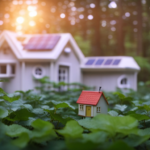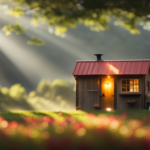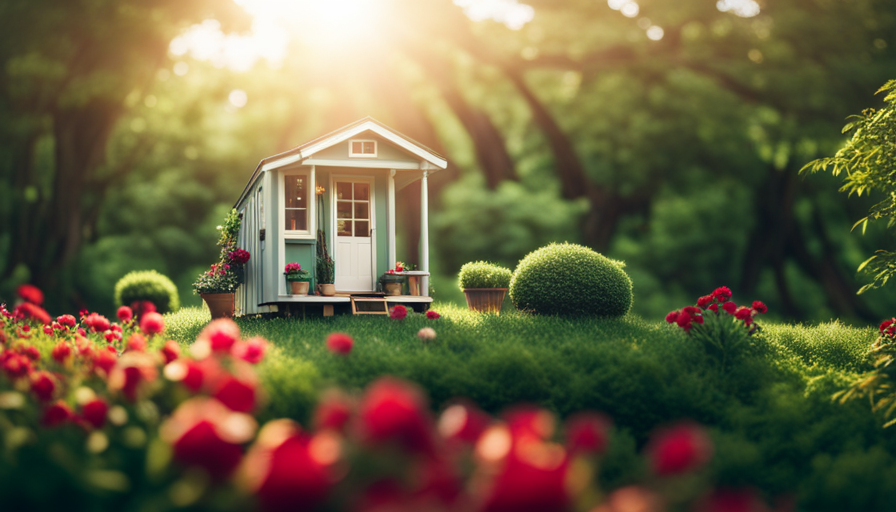Have you ever dreamed of escaping the pressures of modern life for a simpler, more environmentally friendly lifestyle? If so, I have exciting news: building a tiny home might be the solution you’ve been searching for.
In this article, I will guide you through the step-by-step process of constructing your very own tiny house, from determining your goals and needs to enjoying the finished product.
But before we dive into the nitty-gritty details, let me leave you hanging for just a moment. Imagine waking up every morning in a cozy, self-built home that perfectly suits your lifestyle.
Picture yourself surrounded by nature, with the freedom to roam and explore at your leisure. Now, imagine the satisfaction of knowing that you’ve created a space that is not only beautiful, but also environmentally friendly and energy efficient.
Sounds enticing, doesn’t it? Well, get ready to turn your dreams into reality, because I’m about to reveal the secrets of building a tiny house.
So grab a pen and paper, and let’s get started on this exciting journey together.
Key Takeaways
- Determining goals and needs is crucial when building a tiny house.
- Prioritizing functionality and maximizing limited space is essential in the design process.
- Using sustainable and eco-friendly materials is important for a more sustainable lifestyle.
- Considering renewable energy sources like solar panels can greatly reduce energy costs and reliance on the grid.
Determine Your Goals and Needs
To build a tiny house, you should first determine what your goals and needs are, so that you can create a space that’s not only functional, but also reflects your unique personality and lifestyle. Setting priorities is essential in this process, as it helps you focus on what matters most to you.
Consider questions such as: Do you want a mobile or stationary tiny house? How many rooms do you need? What amenities are essential for your daily life? By answering these questions, you can establish a clear vision for your tiny house project.
Once you’ve identified your goals and needs, the next step is to choose the right design. There are various designs available, ranging from traditional to modern, and each offers different features and advantages. Take the time to research and explore different options, considering factors such as the layout, storage solutions, and overall aesthetic appeal. It’s important to find a design that not only meets your functional requirements, but also aligns with your personal style and preferences.
After setting your priorities and choosing the right design, the next step is to find the perfect location for your tiny house. Transitioning into this section, it’s crucial to consider factors such as zoning regulations, access to utilities, and proximity to amenities. By carefully selecting the location, you can ensure that your tiny house fits seamlessly into its surroundings and enhances your overall living experience without compromise.
Find the Perfect Location
When looking for the ideal spot, you’ll be amazed by the number of stunning locations available for your dream tiny home. Choosing the right location is crucial to ensure that your tiny house meets your needs and desires.
Here are four key factors to consider when finding the ideal spot:
-
Accessibility: Look for a location that’s easily accessible and convenient for your daily activities, such as work, school, or shopping. Consider the distance to amenities and services you frequently use.
-
Climate: Take into account the climate of the area you’re considering. Think about whether you prefer a warm and sunny location or a cooler, more temperate climate. Remember that extreme weather conditions may affect the comfort and maintenance of your tiny house.
-
Surroundings: Think about the surroundings you desire for your tiny home. Do you prefer a secluded spot in nature, close to hiking trails and scenic views? Or would you rather be part of a vibrant community with shared amenities and social activities?
-
Legal Considerations: Ensure that the location you choose complies with local zoning and building regulations. Research any restrictions or permits required for tiny houses in the area.
Finding the perfect location is the first step in creating your dream tiny house. Once you’ve chosen the ideal spot, you can move on to designing your tiny home, incorporating your personal style and needs.
Design Your Tiny House
Crafting your ideal tiny home is an opportunity to unleash your creativity and design a space that truly reflects your unique style and needs. When it comes to designing your tiny house, the layout is key. With limited space, it’s important to make every square inch count.
Start by considering your daily routines and prioritize the essential elements you need in your tiny home. Think about the flow of the space and how you can maximize its functionality.
One popular layout for tiny houses is the open concept design, where the living, dining, and kitchen areas are combined into a single space. This layout allows for better natural light and creates a sense of openness. Another option is to have separate rooms, such as a bedroom, bathroom, and kitchenette, for added privacy.
To maximize space, consider incorporating multi-functional furniture, such as a sofa that can also be used as a bed or storage ottomans that double as seating. Utilize vertical space by installing shelves or wall-mounted storage units. Additionally, choose light colors for your walls and furniture to create an illusion of more space.
In the next section, we will discuss how to gather the materials and tools needed for your tiny house project.
Gather Materials and Tools
When it comes to gathering materials and tools for building a tiny house, I always start by researching sustainable and eco-friendly options. This not only helps to reduce my environmental impact, but also ensures that my tiny house is built to last.
Additionally, I make a detailed list of all the necessary tools and equipment I’ll need throughout the construction process. This helps me stay organized and ensures that I have everything I need to complete the project efficiently.
Research sustainable and eco-friendly building materials
To create a truly eco-friendly and sustainable tiny house, you can use reclaimed wood, recycled insulation, and solar panels to harness the power of the sun. Sustainable building materials offer numerous benefits, including reduced environmental impact and improved energy efficiency.
Reclaimed wood is a cost-effective option that adds character to your tiny house while reducing the demand for new timber.
Recycled insulation, made from materials like denim or cellulose, helps regulate temperature and reduces energy consumption.
Solar panels are an excellent addition for energy efficient designs, providing electricity and reducing dependence on the grid. However, it’s important to consider the cost and availability of these materials, as well as their potential drawbacks.
With careful research and planning, you can build a tiny house that’s both sustainable and efficient.
Now, let’s move on to making a list of necessary tools and equipment.
Make a list of necessary tools and equipment
One interesting statistic to consider when making a list of necessary tools and equipment for an eco-friendly and sustainable tiny house is that using energy-efficient appliances can reduce electricity consumption by up to 50%. When choosing the right tools for building a tiny house, it’s crucial to prioritize sustainability and efficiency.
Here is a list of necessary tools and equipment to consider:
- Recycled and reclaimed materials: Opt for salvaged materials to reduce waste and lower the environmental impact.
- Non-toxic paints and finishes: Choose eco-friendly options that are free from harmful chemicals and VOCs.
- Renewable energy sources: Install solar panels or wind turbines to power your tiny house sustainably.
- Water-efficient fixtures: Use low-flow faucets, showerheads, and toilets to conserve water.
- Insulation materials: Select eco-friendly insulation options like recycled denim or cellulose.
By carefully considering these tools and equipment, you can ensure that your tiny house is built in an environmentally friendly and sustainable manner.
In the next section, we’ll discuss how to build the foundation for your tiny house.
Build the Foundation
Start by digging the foundation for your tiny house, feeling the thrill of laying the groundwork for your dream home. Before you start, it’s important to determine your budget and select the appropriate building materials. Consider factors such as cost, durability, and sustainability when making these decisions.
Once you have everything in place, you can start the exciting process of building the foundation.
First, mark the layout of your tiny house on the ground using stakes and string. This will give you a clear idea of the dimensions and ensure that the foundation is aligned properly.
Next, start digging the trenches for the footings. The depth and width of the trenches will depend on the type of foundation you choose, whether it’s a concrete slab or a pier and beam foundation.
After the trenches are dug, it’s time to pour the concrete footings. Make sure to follow the instructions carefully, as the correct mixture and curing time are crucial for a strong foundation.
Once the footings are set, you can proceed to build the foundation walls, using materials such as concrete blocks or pressure-treated lumber.
With the foundation complete, you are now ready to move on to the next phase of construction: constructing the frame and walls. This stage will bring your tiny house one step closer to becoming a reality.
Construct the Frame and Walls
After completing the foundation of your tiny house, it’s time to move on to the next crucial step: constructing the frame and walls. This is where the design of your tiny house really starts to take shape.
When it comes to tiny house design, there are several options to consider. You can choose between a traditional stick-built frame or opt for a more modern approach, like using steel or SIPs (Structural Insulated Panels). Each option has its pros and cons, so it’s important to research and decide which one best suits your needs and budget.
Once you have chosen the frame type, it’s time to start building the walls. Insulation is a key consideration in a tiny house, as it helps maintain a comfortable temperature and reduces energy consumption. There are various insulation options available, such as spray foam, rigid foam, or eco-friendly alternatives like sheep’s wool or recycled denim. Choose the insulation material that aligns with your priorities, whether it’s energy efficiency, sustainability, or cost-effectiveness.
As you construct the frame and walls, it’s crucial to follow building codes and regulations to ensure the structural integrity and safety of your tiny house. Remember to consult professionals or experienced builders if needed.
Now that the frame and walls are taking shape, it’s time to move on to the next step: installing plumbing and electrical systems.
Install Plumbing and Electrical Systems
When it comes to installing plumbing and electrical systems in a tiny house, it’s crucial to carefully plan your water and wastewater systems. This includes determining the best layout and ensuring proper connections for a functional and efficient system.
Additionally, hiring a professional electrician is highly recommended to ensure safe electrical wiring and adherence to building codes.
Plan your water and wastewater systems
To ensure a sustainable lifestyle in your tiny house, it’s crucial to carefully plan and design efficient water and wastewater systems. Water conservation is key in a small space, so consider installing low-flow fixtures and a rainwater collection system. This will help reduce water usage and minimize your ecological footprint. Additionally, you’ll need to plan for wastewater treatment by incorporating a composting toilet or a greywater system. A composting toilet is a great option as it converts human waste into nutrient-rich compost, while a greywater system recycles water from sinks and showers for irrigation purposes. By implementing these water and wastewater systems, you can live more sustainably in your tiny house. Moving forward, it is essential to hire a professional electrician for safe electrical wiring in your tiny house, ensuring that all your power needs are met efficiently and securely.
Hire a professional electrician for safe electrical wiring
To ensure the functionality and sustainability of your tiny house, it’s crucial to plan your water and wastewater systems meticulously. However, another vital aspect that requires professional attention is the electrical wiring. Hiring a skilled electrician can guarantee safe and efficient installation, preventing any potential hazards.
The benefits of solar power in tiny houses can’t be overstated. By harnessing the sun’s energy, you can significantly reduce your reliance on the grid and lower your energy costs. Additionally, proper insulation is paramount for maintaining a comfortable living environment and maximizing energy efficiency. It helps regulate temperature, reduce noise, and prevent moisture build-up.
To achieve these goals, here are four key factors to consider:
- Determine your energy needs and choose the right solar system size.nn2. Install high-quality solar panels and batteries for long-term performance.nn3. Optimize the orientation and placement of solar panels for maximum sunlight exposure.nn4. Ensure proper insulation materials and techniques are used throughout your tiny house.
By addressing these aspects, you can create a sustainable and energy-efficient living space.
Now, let’s move on to finishing the interior, where we’ll transform the bare bones of your tiny house into a cozy and functional home.
Finish the Interior
When it comes to finishing the interior of a tiny house, there are three key points to consider.
First, I need to choose the right flooring, paint, and finishes to create a cohesive and visually appealing space.
Second, I’ll install cabinets, countertops, and appliances to maximize storage and functionality in the limited space.
Lastly, I’ll ensure that all these elements come together harmoniously to create a comfortable and inviting living environment.
Choose flooring, paint, and finishes
Wow, choosing the flooring, paint, and finishes for your tiny house can be an absolute game-changer in transforming it from a simple structure to a stunning and cozy home! When it comes to flooring, it’s important to select durable materials that can withstand heavy foot traffic and potential moisture. Options like hardwood, vinyl, or tile can be great choices. In terms of paint, lighter colors can make your tiny space feel more open and airy, while darker colors can add a touch of sophistication. When selecting finishes, consider the overall color scheme and style of your tiny house. Incorporating contrasting textures and materials can add visual interest and depth. Now, let’s move on to the next step of installing cabinets, countertops, and appliances to complete your dream tiny house.
Install cabinets, countertops, and appliances
Now it’s time to bring your dream home to life by installing cabinets, countertops, and appliances. Choosing stylish options is essential to create a visually appealing and functional space.
Opt for sleek and modern cabinets that maximize storage capacity while adding a touch of elegance to your tiny house. Consider countertops made of durable materials like quartz or stainless steel, which not only enhance the aesthetics but also withstand daily wear and tear.
When selecting appliances, prioritize energy efficiency to reduce your carbon footprint and save on utility bills. Compact and multi-functional appliances are ideal for maximizing space usage in a tiny house.
By carefully selecting these elements, you can create a beautiful and efficient kitchen that fits perfectly into your tiny home.
Enhancing your tiny house’s energy efficiency is the next step towards creating a sustainable and eco-friendly living space.
Make it Energy Efficient
To make a tiny house energy efficient, you can install solar panels on the roof. Solar panels convert sunlight into electricity, which can power various appliances and reduce your reliance on the grid. Additionally, using energy-efficient insulation materials can help maintain a comfortable indoor temperature while minimizing energy consumption. It is important to choose insulation materials with high R-values, such as spray foam or cellulose insulation, to ensure maximum efficiency.
In order to emphasize the benefits of solar panel installation, consider the following table:
| Advantages of Solar Panels | Disadvantages of Solar Panels |
|---|---|
| Renewable energy source | Initial installation cost |
| Reduces electricity bills | Dependence on sunlight |
| Environmentally friendly | Maintenance and repairs |
| Potential for tax incentives | Limited energy storage |
By investing in solar panels and energy-efficient insulation, you can significantly decrease your ecological footprint and save money in the long run. Once your tiny house is energy efficient, you can enjoy a more sustainable lifestyle and reap the benefits of reduced energy costs. So, let’s move on to the next section and explore how to fully enjoy your new tiny house.
Enjoy Your New Tiny House
Experience the joy of living in your cozy, eco-friendly haven and savor the simple pleasures of your new tiny home. Now that you’ve successfully built your tiny house, it’s time to make the most of the limited space and personalize it to reflect your unique style.
Here are some tips to help you maximize space and decorate your tiny house:
-
Utilize vertical space: In a tiny house, every square inch counts. Install floating shelves or wall-mounted storage units to keep your belongings organized and off the floor. Hang curtains or blinds high to create the illusion of taller ceilings.
-
Choose multipurpose furniture: Invest in furniture that serves more than one function. Opt for a sofa bed or a coffee table with hidden storage compartments. Foldable tables and chairs can be easily tucked away when not in use.
-
Keep it minimalistic: To avoid clutter, embrace a minimalistic approach to decorating. Choose a neutral color palette that creates a sense of openness and tranquility. Use mirrors strategically to make the space appear larger.
By implementing these decorating tips, you can transform your tiny house into a stylish and functional living space. Enjoy the freedom that comes with living in a smaller home and relish in the simplicity and coziness it offers.
Frequently Asked Questions
What are some common challenges or obstacles people face when building a tiny house?
When it comes to building a tiny house, there are a few common challenges and design considerations to keep in mind.
One of the most ironic challenges is the limited space, which can make it a bit challenging to find creative storage solutions.
Additionally, ensuring proper insulation and ventilation is crucial, as these small spaces can quickly become stuffy.
Finally, zoning and building regulations can pose obstacles, so it’s important to do your research before diving into the project.
Are there any legal considerations or zoning regulations I need to be aware of when choosing a location for my tiny house?
When choosing a location for your tiny house, it’s crucial to consider legal considerations and zoning regulations. Understanding the specific laws and regulations in the area you plan to build is essential to avoid any legal issues. Some areas may have restrictions on the size, location, and even the type of structure allowed. It’s important to research and comply with all zoning regulations to ensure a smooth and legal process for building your tiny house.
How long does it typically take to build a tiny house from start to finish?
Building a tiny house is like embarking on a captivating journey. The timeline for constructing a tiny house varies depending on factors such as size, complexity, and available resources. Generally, the construction process takes several months, from the initial design phase to the final touches.
It involves tasks like securing permits, acquiring materials, and executing the build. By carefully planning and dedicating time and effort, one can successfully create their dream tiny house.
What are some cost-saving tips or strategies for building a tiny house on a budget?
Cost-saving strategies for building a tiny house on a budget include opting for a DIY construction approach. By handling the construction yourself, you can save on labor costs.
Additionally, sourcing affordable materials from salvage yards or repurposing items can significantly reduce expenses.
Careful planning and budgeting, as well as researching cost-effective design options, can also help keep expenses in check.
With these strategies, you can create an affordable and personalized tiny house without compromising on quality or style.
Are there any resources or organizations that provide support or guidance for individuals interested in building a tiny house?
When it comes to building a tiny house, there are numerous resources, organizations, and support systems available to assist you along the way. These invaluable sources offer guidance and expertise on common challenges and obstacles, including legal considerations such as zoning regulations.
They can also provide insight into choosing the right location, estimating the time it takes to build, and implementing cost-saving tips and strategies to stay within your budget.
Conclusion
In conclusion, building a tiny house has been an incredible journey filled with excitement, challenges, and rewards.
By determining my goals and needs, finding the perfect location, and designing a personalized space, I was able to create a home that perfectly suited my lifestyle.
Gathering materials and tools, building a solid foundation, and installing plumbing and electrical systems were essential steps in bringing my vision to life.
By finishing the interior with attention to detail and making it energy efficient, I’ve created a cozy and sustainable haven.
Now, it’s time to sit back, relax, and enjoy the fruits of my labor in this incredible tiny house.
Hi, I’m Emma. I’m the Editor in Chief of Tiny House 43, a blog all about tiny houses. While tree houses are often associated with childhood, they can be the perfect adult retreat. They offer a cozy space to relax and unwind, surrounded by nature. And since they’re typically built on stilts or raised platforms, they offer stunning views that traditional homes simply can’t match. If you’re looking for a unique and romantic getaway, a tree house tiny house might just be the perfect option.
